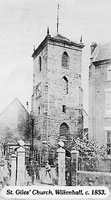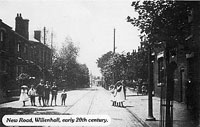Willenhall in history

The first record of the settlement of Willenhall is from the eighth century when a treaty was signed there by King Ethelbald of Mercia. Willenhall was then referred to as Willenhalch which in Anglo-Saxon meant 'the meadowland of Willan'. Willenhala was mentioned in the Domesday Book (1086) as a very small settlement, and it remained so until the growth of industry in the 18th century.
In the Middle Ages, Willenhall was included in the parish of Wolverhampton. Although there was a church in the village, people would have to travel to Wolverhampton for weddings and funerals. It was not until 1840 that Willenhall had a parish church. St. Giles was the first church to be built. The present church is the third on the site, dating from 1867.
Willenhall was a small agricultural village throughout the Middle Ages, in 1666 the population was only about 300. The population did not increase dramatically until the 18th century when iron and coal began to be fully exploited. The town grew up around the Market Place and Stafford Street with many tiny streets crammed with houses, workshops and pubs. Evidence of the town's growing prosperity is still visible today in the Dale House, once the home of the Hincks family and 33 Market Place, the home of the Clemsons, both maltsters.

To make trading easier, New Road was opened in the early 19th century. Outside the town itself, settlements grew up around local industries. The area around Lane Head and Sandbeds had a thriving mining community and Portobello grew around the brickmaking industry. There was a lot of coal mining in the Willenhall area until the 19th century when the industry came to a dramatic halt after a strike when the mines were flooded and lost forever. The main industry in Willenhall, for which it has become famous, is lockmaking. Lockmaking began in the area in Elizabethan times mainly in Wolverhampton, Willenhall and Bilston. It was concentrated in Willenhall by the mid 19th century; one source quotes 340 lockmakers in Willenhall in 1855, mostly in small workshops. Locks at this time were made entirely by hand. Young apprentices filed the metal which resulted after many years in their having hump backs. This deformity was so prevalent that Willenhall became known as 'Humpshire'. Famous lockmakers in Willenhall include Josiah Parkes & Sons, Yale & Towne and John Harper & Co.
Poor housing and lack of any proper sanitation led to a cholera epidemic in 1849 when 292 people died. The epidemic shocked the town into improving conditions and in 1854 the Willenhall Local Board of Health was founded, a forerunner of Willenhall Urban District Council which took over in 1894. To reflect a growth in civic pride several municipal buildings were erected, the Town Hall and Library building in Clemson Street in 1866, a public baths in 1938. The memorial park was opened in 1922 in honour of those killed in World War 1.
Willenhall became part of Walsall Metropolitan Borough in 1966 but remains very much a town with its own identity.
Walsall Local History Centre